We’ve been awfully excited to use 100% recycled plastic for the shells of our robotic construction kit. We were going to end up using two materials for the blocks: black recycled ABS and clear recycled PET (from soda bottles). Using materials that have already been around the block and into the bin made us feel better about our contribution to the mountain of stuff around us. And that’s why it’s pretty upsetting to find out that we probably cannot use recycled plastic at all.
In 2008, the Consumer Product Safety Improvement Act (CPSIA) was signed into law in the US. Don’t get us wrong, the law is a good thing: it protects kids from lead and other harmful substances in toys, and requires mandatory third party testing for all children’s products. One important group of substances regulated by the new law is phthalates, which are chemicals added to plastic during manufacturing to make them more flexible and durable. Heavy exposure to phthalates, unfortunately, has been shown to cause endocrine disruption and infertility.
To comply with the CPSIA, our plastic must meet a certain requirement for phthalate levels. But since recycled plastics are just a mix of old plastics ground up and reheated, no supplier will guarantee that every part will meet the requirements. So while we haven’t given up on our search for a better option, unfortunately it looks like our only option is to use virgin plastic. Any thoughts?
Category: Uncategorized
A tip of the hat to Pittsburgh’s Kids & Creativity group – a loosely linked collection of artists, media folk, museum directors, hackers, teachers, professors, businesses, philanthropists, all working to make the Pittsburgh region an amazing place to be a kid. And because Pittsburgh is a center for both technology and the arts, many of the projects work at this intersection. The group — now about a hundred strong — meets monthly for a vibrant exchange of information and ideas, and yesterday’s meeting at the Carnegie Science Center was a flood of conference and meeting reports, from the Game Developers to Interaction Design for Children to SIGGRAPH. I’m relatively new to Pittsburgh (5 years now) and through Kids and Creativity I get to hang out with the most amazing and committed and imaginative people. Kudos to Gregg Behr, executive director of the Grable Foundation, who seems to know everyone and has that special knack to bring very disparate worlds together.
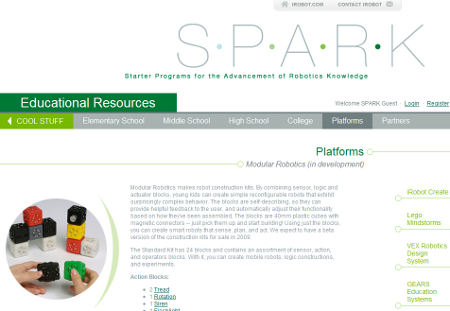 Educational robotics is a mess. There are a bunch of different platforms, and teaching materials can be ad-hoc. The contests have been successful but the First people don’t talk to the Botball people. That’s why we’re pleased that iRobot has started putting together SPARK, an educational resource site for teachers and students. They’re collecting information and activities and trying to start a lively educational robotics community.
It’s nice to see Modular Robotics listed up there next to heavyweights like LEGO and VEX. Thanks, iRobot, for developing an inclusive community site dedicated to improving educational robotics.
Educational robotics is a mess. There are a bunch of different platforms, and teaching materials can be ad-hoc. The contests have been successful but the First people don’t talk to the Botball people. That’s why we’re pleased that iRobot has started putting together SPARK, an educational resource site for teachers and students. They’re collecting information and activities and trying to start a lively educational robotics community.
It’s nice to see Modular Robotics listed up there next to heavyweights like LEGO and VEX. Thanks, iRobot, for developing an inclusive community site dedicated to improving educational robotics.
3D printers are amazing tools: design an object on your computer, hit control-P, and when you come back from lunch, a nice warm plastic part is waiting for you. For a few years now, I’ve been making prototype plastic parts on a trusty Stratasys Dimension. It’s quick and makes robust ABS parts at the touch of a button: I just draw in Solidworks and usually have a finished part the next day. But at the scale of parts for the robotic construction kit that we’re working on, we’ve run up against a resolution wall. The Dimension, with a resolution of about 178 microns, just can’t print print the fine details I need at this stage of design.
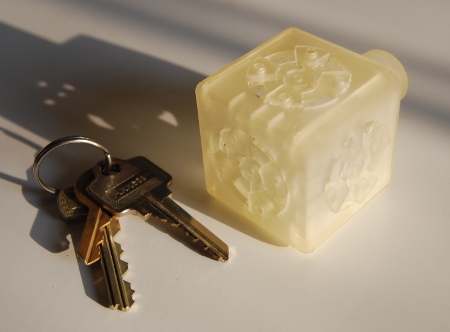 Enter the Objet Eden. It’s different technology; the material is deposited by a bunch of print heads in parallel, much more like an inkjet printer than the “hot glue gun on a robot” style of FDM. And the parts are beautiful. Layers are only 16 microns (16 microns!) thick, so parts are smooth to the touch, even shiny, when they come out. The picture above is a test print of a 40mm cube, and it’s perfectly smooth; no ridges or bumps. It’s fast, too — these parts printed in 80 minutes. The material seems strong and durable, and the support material washes off with water. The only catch is that the machine costs about $115,000.
Enter the Objet Eden. It’s different technology; the material is deposited by a bunch of print heads in parallel, much more like an inkjet printer than the “hot glue gun on a robot” style of FDM. And the parts are beautiful. Layers are only 16 microns (16 microns!) thick, so parts are smooth to the touch, even shiny, when they come out. The picture above is a test print of a 40mm cube, and it’s perfectly smooth; no ridges or bumps. It’s fast, too — these parts printed in 80 minutes. The material seems strong and durable, and the support material washes off with water. The only catch is that the machine costs about $115,000.
 Enter the Objet Eden. It’s different technology; the material is deposited by a bunch of print heads in parallel, much more like an inkjet printer than the “hot glue gun on a robot” style of FDM. And the parts are beautiful. Layers are only 16 microns (16 microns!) thick, so parts are smooth to the touch, even shiny, when they come out. The picture above is a test print of a 40mm cube, and it’s perfectly smooth; no ridges or bumps. It’s fast, too — these parts printed in 80 minutes. The material seems strong and durable, and the support material washes off with water. The only catch is that the machine costs about $115,000.
Enter the Objet Eden. It’s different technology; the material is deposited by a bunch of print heads in parallel, much more like an inkjet printer than the “hot glue gun on a robot” style of FDM. And the parts are beautiful. Layers are only 16 microns (16 microns!) thick, so parts are smooth to the touch, even shiny, when they come out. The picture above is a test print of a 40mm cube, and it’s perfectly smooth; no ridges or bumps. It’s fast, too — these parts printed in 80 minutes. The material seems strong and durable, and the support material washes off with water. The only catch is that the machine costs about $115,000.
I wanted to pick up a 12VDC charger for my fancy new iPhone. I peeked at Apple.com first and found one for $19.95 (plus $4 shipping). Electronics stores like Best Buy had similar offerings. Twenty plus dollars to plug my phone into a cigarette lighter seemed a little expensive especially since I happen to have a bunch of voltage regulators lying around my desk at any given point. I saw that Sparkfun had an iPod plug for $5, but I had already tried my phone with my iPod charger and it didn’t work. Current? Pins? Who knows. Then I did a quick search on eBay.
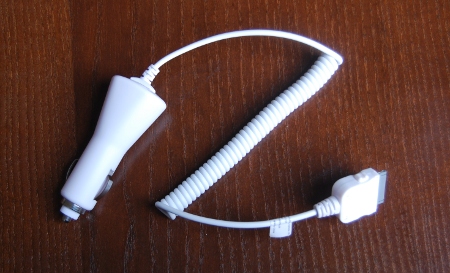 I was skeptical. $0.99 for a charger with free shipping? But the seller had 1,377,576 feedbacks with a 99.7% success rate. Anyway, what did I have to lose; ninety-nine cents? But two days later the charger you see above arrived at my door and I’m pleased to report that it works swimmingly.
Truthfully, though, I don’t understand how this can happen. I’m currently spending a lot of time and energy trying to reduce the cost of our robots, and while I can imagine being able to make this charger so that it sells for $0.99, I have no idea how they can ship it to me (from CA to NY!) for free. It began its journey with DHL and then was transferred to the US Postal Service, so I’m not even sure where it originated from. Shenzhen?
I was skeptical. $0.99 for a charger with free shipping? But the seller had 1,377,576 feedbacks with a 99.7% success rate. Anyway, what did I have to lose; ninety-nine cents? But two days later the charger you see above arrived at my door and I’m pleased to report that it works swimmingly.
Truthfully, though, I don’t understand how this can happen. I’m currently spending a lot of time and energy trying to reduce the cost of our robots, and while I can imagine being able to make this charger so that it sells for $0.99, I have no idea how they can ship it to me (from CA to NY!) for free. It began its journey with DHL and then was transferred to the US Postal Service, so I’m not even sure where it originated from. Shenzhen?
 I was skeptical. $0.99 for a charger with free shipping? But the seller had 1,377,576 feedbacks with a 99.7% success rate. Anyway, what did I have to lose; ninety-nine cents? But two days later the charger you see above arrived at my door and I’m pleased to report that it works swimmingly.
Truthfully, though, I don’t understand how this can happen. I’m currently spending a lot of time and energy trying to reduce the cost of our robots, and while I can imagine being able to make this charger so that it sells for $0.99, I have no idea how they can ship it to me (from CA to NY!) for free. It began its journey with DHL and then was transferred to the US Postal Service, so I’m not even sure where it originated from. Shenzhen?
I was skeptical. $0.99 for a charger with free shipping? But the seller had 1,377,576 feedbacks with a 99.7% success rate. Anyway, what did I have to lose; ninety-nine cents? But two days later the charger you see above arrived at my door and I’m pleased to report that it works swimmingly.
Truthfully, though, I don’t understand how this can happen. I’m currently spending a lot of time and energy trying to reduce the cost of our robots, and while I can imagine being able to make this charger so that it sells for $0.99, I have no idea how they can ship it to me (from CA to NY!) for free. It began its journey with DHL and then was transferred to the US Postal Service, so I’m not even sure where it originated from. Shenzhen?
We changed our name to Modular Robotics and we have this fantastic new logo. I think it would make a really good sticker. Or maybe we’ll give away stencils for it and cans of baby blue spray paint. We haven’t settled on the new name for the kit yet, but we’re getting there. Instead of roblocks.org, find us at www.modrobotics.com.
 Maker Faire is May 30 and 31 at the San Mateo County Expo Center. If you’re going to be there, come say hi! We’re keeping a pretty low profile since our next hardware version isn’t ready yet, but you’ll find us in a corner of the MIT Media Lab booth with a pile of blocks — it’s right in between booths for the Exploratorium and Sparkfun. Three of our favorite things all lined up in a row!
Maker Faire is May 30 and 31 at the San Mateo County Expo Center. If you’re going to be there, come say hi! We’re keeping a pretty low profile since our next hardware version isn’t ready yet, but you’ll find us in a corner of the MIT Media Lab booth with a pile of blocks — it’s right in between booths for the Exploratorium and Sparkfun. Three of our favorite things all lined up in a row! 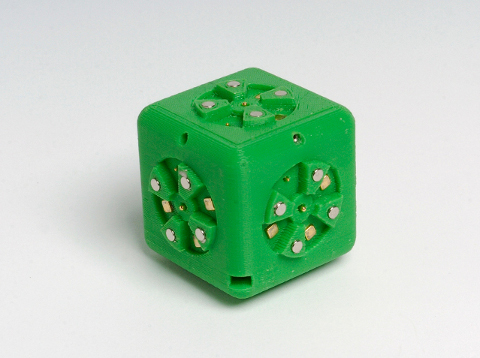 Our roBlocks prototype (above) uses seven tiny magnets on each face of each cube. On each connector, there are protruding keys (with silver cylinder magnets) and recessed keys (with gold cube magnets). When you put two blocks together, the cylinders (polarized N) attract the cubes (polarized S) and (click!) the magnetic attraction force holds them together. Little magnets are expensive, though, and can also be dangerous if little kids can get their hands on them. So we’re thinking about replacing the recessed magnets with regular old steel, but I had a hard time figuring out how this would effect the magnetic attraction force. Would it reduce it by 50% since we’re eliminating one magnet? Would it be the same since the single magnet induces poles in the steel? I asked some of the engineers in my lab and they had answers as varied as mine. I even called my friend Pete who’s an astrophysicist at a Lawrence Livermore, but that just led to a lot of mumbling and Greek letters. Finally, I broke down and called a magnet store. Their answer? Replacing one of the magnets will generally reduce the attraction force by about 15%. So there you go.
Our roBlocks prototype (above) uses seven tiny magnets on each face of each cube. On each connector, there are protruding keys (with silver cylinder magnets) and recessed keys (with gold cube magnets). When you put two blocks together, the cylinders (polarized N) attract the cubes (polarized S) and (click!) the magnetic attraction force holds them together. Little magnets are expensive, though, and can also be dangerous if little kids can get their hands on them. So we’re thinking about replacing the recessed magnets with regular old steel, but I had a hard time figuring out how this would effect the magnetic attraction force. Would it reduce it by 50% since we’re eliminating one magnet? Would it be the same since the single magnet induces poles in the steel? I asked some of the engineers in my lab and they had answers as varied as mine. I even called my friend Pete who’s an astrophysicist at a Lawrence Livermore, but that just led to a lot of mumbling and Greek letters. Finally, I broke down and called a magnet store. Their answer? Replacing one of the magnets will generally reduce the attraction force by about 15%. So there you go. 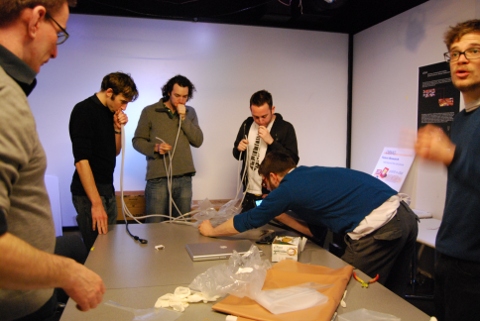 Last weekend I got to play with an amazing group of people at a two day workshop in Boston. It was called Programming Reality: From Transitive Materials to Organic User Interfaces and was part of the CHI 2009 conference. We spent the second day at the MIT Media Lab where we broke into small groups to work on design sketches of future systems. One group made a flexible display out of silicone, another made a laser-cut laminated material that undulated from the motion of embedded paper cones. There was a rollable input device and an augmented shrine to personal robots. Our group made a prototype of an inflatable display — we built plastic pixels using the ultrasonic welder and manually inflated them through a series of tubes. Generally, we were all interested in how people are going to interact with future stuff. When everything around us is computational or robotic, how are we going to manage it all? Even now it seems that we don’t really program computers anymore, we program the world around us.
Last weekend I got to play with an amazing group of people at a two day workshop in Boston. It was called Programming Reality: From Transitive Materials to Organic User Interfaces and was part of the CHI 2009 conference. We spent the second day at the MIT Media Lab where we broke into small groups to work on design sketches of future systems. One group made a flexible display out of silicone, another made a laser-cut laminated material that undulated from the motion of embedded paper cones. There was a rollable input device and an augmented shrine to personal robots. Our group made a prototype of an inflatable display — we built plastic pixels using the ultrasonic welder and manually inflated them through a series of tubes. Generally, we were all interested in how people are going to interact with future stuff. When everything around us is computational or robotic, how are we going to manage it all? Even now it seems that we don’t really program computers anymore, we program the world around us. 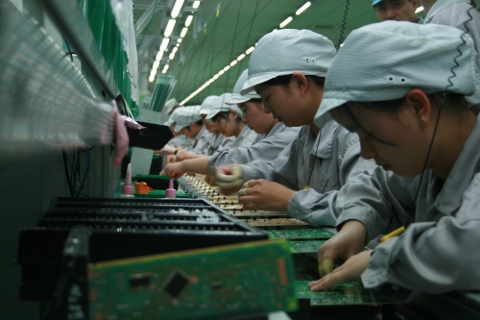 It turns out I really had no idea how things are made! We just spent a week in Shenzhen and Guanzhou, two manufacturing cities close to Hong Kong. This is where our shoelaces, iPods, dog toys, cameras, T-shirts, bicycles, and laptops come from. We toured a bunch of different factories and tried to understand firsthand what it means to make the decision to mass-produce a piece of consumer electronics. We were only allowed to see the best (in the human rights and environmental sense) factories, but it was an eye opener how much manual labor is involved in production. This disposable cap on my water bottle was probably directly handled by six different people before it was packed to ship. One of the best parts of the trip was getting to spend some time with the amazing people in our group. Many more photos and videos on their blogs and flickrs:
It turns out I really had no idea how things are made! We just spent a week in Shenzhen and Guanzhou, two manufacturing cities close to Hong Kong. This is where our shoelaces, iPods, dog toys, cameras, T-shirts, bicycles, and laptops come from. We toured a bunch of different factories and tried to understand firsthand what it means to make the decision to mass-produce a piece of consumer electronics. We were only allowed to see the best (in the human rights and environmental sense) factories, but it was an eye opener how much manual labor is involved in production. This disposable cap on my water bottle was probably directly handled by six different people before it was packed to ship. One of the best parts of the trip was getting to spend some time with the amazing people in our group. Many more photos and videos on their blogs and flickrs:


